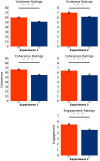The Importance of Semantic Network Brain Regions in Integrating Prior Knowledge with an Ongoing Dialogue
- PMID: 36096648
- PMCID: PMC9491346
- DOI: 10.1523/ENEURO.0116-22.2022
The Importance of Semantic Network Brain Regions in Integrating Prior Knowledge with an Ongoing Dialogue
Abstract
To understand a dialogue, we need to know the topics that are being discussed. This enables us to integrate our knowledge of what was said previously to interpret the current dialogue. This study involved a large-scale behavioral experiment conducted online and a separate fMRI experiment, both testing human participants. In both, we selectively manipulated knowledge about the narrative content of dialogues presented in short videos. The clips were scenes from situation comedies that were split into two parts. The speech in the part 1 clips could either be presented normally or spectrally rotated to render it unintelligible. The part 2 clips that concluded the scenes were always presented normally. The behavioral experiment showed that knowledge of the preceding narrative boosted memory for the part 2 clips as well as increased the intersubject semantic similarity of recalled descriptions of the dialogues. The fMRI experiment replicated the finding that prior knowledge improved memory for the conclusions of the dialogues. Furthermore, prior knowledge strengthened temporal intersubject correlations in brain regions including the left angular gyrus and inferior frontal gyrus. Together, these findings show that (1) prior knowledge constrains the interpretation of a dialogue to be more similar across individuals; and (2), consistent with this, the activation of brain regions involved in semantic control processing is also more similar between individuals who share the same prior knowledge. Processing in these regions likely supports the activation and integration of prior knowledge, which helps people to better understand and remember dialogues as they unfold.
Keywords: fMRI; memory; prior knowledge; semantic.
Copyright © 2022 Raykov et al.
Figures





Similar articles
-
Age differences in the neural processing of semantics, within and beyond the core semantic network.Neurobiol Aging. 2023 Nov;131:88-105. doi: 10.1016/j.neurobiolaging.2023.07.022. Epub 2023 Jul 25. Neurobiol Aging. 2023. PMID: 37603932
-
Causal Evidence for a Mechanism of Semantic Integration in the Angular Gyrus as Revealed by High-Definition Transcranial Direct Current Stimulation.J Neurosci. 2016 Mar 30;36(13):3829-38. doi: 10.1523/JNEUROSCI.3120-15.2016. J Neurosci. 2016. PMID: 27030767 Free PMC article.
-
TMS Reveals Dynamic Interaction between Inferior Frontal Gyrus and Posterior Middle Temporal Gyrus in Gesture-Speech Semantic Integration.J Neurosci. 2021 Dec 15;41(50):10356-10364. doi: 10.1523/JNEUROSCI.1355-21.2021. Epub 2021 Nov 16. J Neurosci. 2021. PMID: 34785579 Free PMC article.
-
The neurocognitive basis of knowledge about object identity and events: dissociations reflect opposing effects of semantic coherence and control.Philos Trans R Soc Lond B Biol Sci. 2020 Feb 3;375(1791):20190300. doi: 10.1098/rstb.2019.0300. Epub 2019 Dec 16. Philos Trans R Soc Lond B Biol Sci. 2020. PMID: 31840592 Free PMC article. Review.
-
A meta-analysis of fMRI studies on Chinese orthographic, phonological, and semantic processing.Neuroimage. 2012 Oct 15;63(1):381-91. doi: 10.1016/j.neuroimage.2012.06.047. Epub 2012 Jul 1. Neuroimage. 2012. PMID: 22759996 Review.
Cited by
-
No effect of apolipoprotein E polymorphism on MRI brain activity during movie watching.Brain Neurosci Adv. 2025 Jan 31;9:23982128251314577. doi: 10.1177/23982128251314577. eCollection 2025 Jan-Dec. Brain Neurosci Adv. 2025. PMID: 39896129 Free PMC article.
-
Hippocampus and temporal pole functional connectivity is associated with age and individual differences in autobiographical memory.Proc Natl Acad Sci U S A. 2022 Oct 11;119(41):e2203039119. doi: 10.1073/pnas.2203039119. Epub 2022 Oct 3. Proc Natl Acad Sci U S A. 2022. PMID: 36191210 Free PMC article.
-
Temporal pole volume is associated with episodic autobiographical memory in healthy older adults.Hippocampus. 2022 May;32(5):373-385. doi: 10.1002/hipo.23411. Epub 2022 Mar 5. Hippocampus. 2022. PMID: 35247210 Free PMC article.
-
What Matters to Others: A High-Threshold Account of Joint Attention.Topoi (Dordr). 2024;43(2):337-348. doi: 10.1007/s11245-024-10021-2. Epub 2024 Apr 17. Topoi (Dordr). 2024. PMID: 38757089 Free PMC article.
-
Prenatal alcohol exposure alters brain structure and neurocognitive outcomes for 6- to 7-year-old children in a South African birth cohort.Alcohol Clin Exp Res (Hoboken). 2025 May;49(5):1028-1041. doi: 10.1111/acer.70048. Epub 2025 Apr 6. Alcohol Clin Exp Res (Hoboken). 2025. PMID: 40189903 Free PMC article.
References
Publication types
MeSH terms
LinkOut - more resources
Full Text Sources
